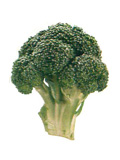|
What You Need to Know About Buying and Eating Organic
There's no doubt that organic food is considerably more expensive than that which is conventionally-farmed. But is it worth it? What's in non-organic food that's potentially bad for you? How is organic better? Maybe you'd like to know what I learned from the good folks at Healthy Planet who kindly allowed me to adapt and reprint information from their Healthy Shopping Survival Guide.
What is Organic Food Anyway?
Organic food is that which is produced without using harmful, conventional pesticides; fertilizers containing synthetic ingredients or sewage sludge; bioengineering; or ionizing radiation. Before being labeled organic, a U.S. Department of Agriculture approved certifier must inspect the farm where the food is grown to ensure that all USDA organic standards are met.
Organic Labels
There are officially-recognized "degrees" of "organic-ness in your food. For more info, click the USDA seal below.
 |
"100% Organic" denotes products that are made of all organic ingredients and may display the USDA seal. |
| "95% or More Organic" certified products may also display the USDA seal. |
| "Made with Organic Ingredients" denotes products containing between 70 and 94% organic ingredients. |
How to Avoid Pesticide Residues in Your Food
The best way to avoid pesticide exposure in
your food is to purchase fewer animal products
and to choose organic produce. Tests have
shown that organic produce has only a fraction of
the pesticide residue of "conventional" produce. However, when buying conventional produce, you can cut your exposure almost 90%
by avoiding the most contaminated fruits and
vegetables and eating the least contaminated
instead! The list below was developed by the Environmental Working Group,
based on the results of nearly 43,000 tests for pesticides on produce by the USDA and the FDA.
Avoid the "Dirty Dozen"
Eating the 12 most contaminated fruits and vegetables will expose you to about 15 pesticides a day, on average. However, eating the 12 least contaminated will expose you to fewer than two pesticides a day:
When NOT Buying Organic... |
 Choose the Best Choose the Best
lowest residue listed first
|
 Avoid the Worst Avoid the Worst
highest residue listed first |
Onions
Blueberries
Papaya
Broccoli
Cabbage
Bananas
Kiwi
Sweet Peas (frozen)
Asparagus
Mango
Pineapples
Sweet Corn (frozen) |
Peaches
Apples
Sweet Bell Peppers
Celery
Nectarines
Strawberries
Cherries
Pears
Grapes (imported)
Spinach
Lettuce
Potatoes |
Cutting Exposure to Residues Isn't the Only Reason to Go Organic
Organic produce and other foods are not only "cleaner" than conventional, they're also proven to be higher in "nutrient density" (i.e. more nutritional bang per calorie). In addition, many people think organic foods taste better.
This following sample is from the comprehensive
nutrient density rating system developed by Joel
Fuhrman, M.D. in response to today's, "low-nutrient eating-style that has led to diseases of nutritional ignorance." The numbers tell us which
foods pack the most nutrients per calorie by taking into account evaluations of all known vitamins and minerals, along with certain carotenoids,
phytonutrients, glucosinates and antioxidants
(the radical scavenging capacity of foods).
Sample Nutrient Densities (nutrients per calorie)
| Kale |
1000 |
|
Tofu |
86 |
|
Bananas |
30 |
| Collards |
1000 |
|
Sweet Potatoes |
83 |
|
Chicken Breast |
27 |
| Bok Choy |
824 |
|
Apples |
76 |
|
Eggs |
27 |
| Spinach |
739 |
|
Peaches |
73 |
|
Low Fat Yogurt, plain |
26 |
| Cabbage |
481 |
|
Kidney Beans |
71 |
|
Corn |
25 |
| Red Pepper |
420 |
|
Green Peas |
70 |
|
Almonds |
25 |
| Romaine Lettuce |
389 |
|
Lentils |
68 |
|
Whole Wheat Bread |
25 |
| Broccoli |
342 |
|
Pineapple |
64 |
|
Feta Cheese |
21 |
| Cauliflower |
295 |
|
Avocado |
64 |
|
Whole Milk |
20 |
| Green Peppers |
258 |
|
Oatmeal |
53 |
|
Ground Beef |
20 |
| Artichoke |
244 |
|
Mangoes |
51 |
|
White Pasta |
18 |
| Carrots |
240 |
|
Cucumbers |
50 |
|
White Bread |
18 |
| Asparagus |
234 |
|
Soybeans |
48 |
|
Peanut Butter |
18 |
| Strawberries |
212 |
|
Sunflower Seeds |
45 |
|
Apple Juice |
16 |
| Tomatoes |
164 |
|
Brown Rice |
41 |
|
Swiss Cheese |
15 |
| Plums |
157 |
|
Salmon |
39 |
|
Potato Chips |
11 |
| Blueberries |
130 |
|
Shrimp |
38 |
|
American Cheese |
10 |
| Iceberg Lettuce |
110 |
|
Skim Milk |
36 |
|
Vanilla Ice Cream |
9 |
| Orange |
109 |
|
White Potatoes |
31 |
|
French Fries |
7 |
| Cantaloupe |
100 |
|
Grapes |
31 |
|
Olive Oil |
2 |
| Flax Seeds |
44 |
|
Walnuts |
29 |
|
Cola |
1 |
Nutrient density food rankings patent pending.
For more info & all ratings go to: http://drfuhrman.com/library/article17.aspx
Next Month: how to read produce labels and know what you're really buying, how to avoid dietary trans fat, and how to choose safer plastic containers for your food. In the meantime, I recommend visiting Healthy Planet's web site at www.healthy-planet.org for information about this terrific organization and all their programs.

Return to Archive
| 

